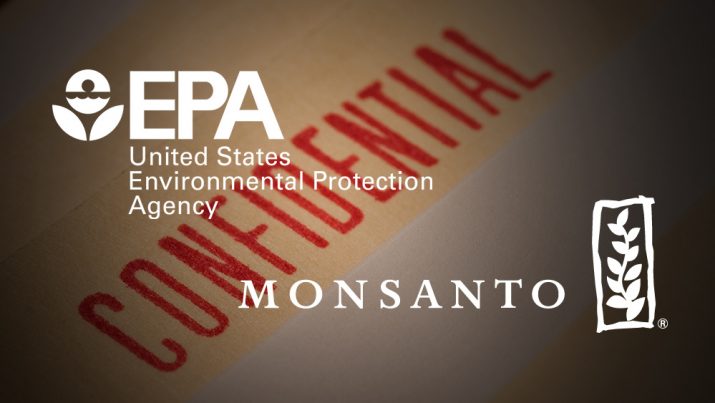
RoundUp Products Liability Litigation: Third-Party Discovery and Pending Motions to Seal
Wednesday, March 15, 2017 by Mike Adams
http://www.products.news/2017-03-15-roundup-products-liability-litigation-third-party-discovery-pending-motions-to-seal.html

This document, and other related documents, come to us via the outstanding investigative work at U.S. Right to Know.
All the released documents are being translated into plain text and re-posted at Glyphosate.news.
The original PDF of this document is found at the USRTK website, with a backup copy archived at Natural News.
###
UNITED STATES DISTRICT COURT NORTHERN DISTRICT OF CALIFORNIA
IN RE: ROUNDUP PRODUCTS LIABILITY LITIGATION
This document relates to: ALL ACTIONS
MDL No. 2741
Case No. 16-md-02741-VC
PRETRIAL ORDER NO. 15: THIRD-PARTY DISCOVERY AND PENDING MOTIONS TO SEAL
Re: Dkt. Nos. 102, 105, 106, 132, 140, 148, 150
This ruling addresses several disputes regarding discovery and several disputes regarding Monsanto’s ability to keep certain documents under seal.
Throughout this litigation the plaintiffs have trumpeted the conclusion of the International Agency for Research on Cancer (“IARC”) that glyphosate is a “probable carcinogen.” As a result, Monsanto is conducting third-party discovery in the hope of finding fault with the IARC’s conclusion.
In turn, Monsanto has trumpeted reports generated by the Environmental Protection Agency (“EPA”) concluding that glyphosate is not hazardous. As a result, the plaintiffs are conducting third-party discovery (and have made Freedom of Information Act requests) in the hope of finding fault with the EPA’s reports.
This raises a general question: whether the reports prepared by agencies like the IARC and EPA are relevant to the first phase of this multi-district litigation. In this phase, which is limited to “general causation,” the Court will decide only whether there is sufficient admissible evidence that glyphosate and/or Roundup is capable of causing cancer (specifically, Non-Hodgkin’s Lymphoma) in humans.
Although Monsanto has taken inconsistent positions on this issue, at the most recent hearing it conceded that the IARC and EPA reports are relevant. Any expert testifying about general causation will, for his opinion to be admissible, almost certainly need to account for the conclusions reached by these agencies.
This does not mean, however, that the IARC and EPA reports are central to the general causation question; it means only that they are relevant. The IARC and EPA reports analyze studies that were previously conducted on the carcinogenicity of glyphosate. The experts in this case will need to do the same thing – that is, they will need to analyze the studies themselves and offer opinions about what they show. The opinions of the IARC and EPA about what the studies show, while important, are secondary. This means that although the parties may conduct some third-party discovery relating to the conclusions drawn by the IARC and the EPA, any such discovery will be limited so that it does not take on an outsized role relative to its importance.
See Fed. R. Civ. P. 26(b)(1) (“Parties may obtain discovery regarding any nonprivileged matter that is relevant to any party’s claim or defense and proportional to the needs of the case . . . .”).
The Court will use this guidepost to consider the plaintiffs’ efforts to take Jess Rowland’s deposition and to compel production of documents relating to his work. Accordingly, the Court is of the tentative view that the testimony and documents the plaintiffs seek from Rowland would be appropriate, but that further discovery from EPA officials would not be. However, the Court will consider any further arguments from the EPA in a motion to quash (to be filed no later than March 28, 2017) before making a final decision. In the event of a motion to quash, the Court will also consider any arguments regarding the application or validity of the EPA’s Touhy regulation.
The same guidepost applies to third-party discovery by Monsanto relating to the IARC report. Accordingly, Texas A&M’s motion to quash the subpoena to Dr. Ivan Rusyn is granted. See Dkt. No. 1, Hardeman v. Monsanto Co., 16-mc-80232. Dr. Rusyn was but one of many participants in the IARC’s glyphosate review. Although the documents in Rusyn’s possession relating to the review may have some relevance, they are not central enough to the litigation to justify the burden such discovery would place on him and the university.1 Moreover, the parties have informed the Court that the chair of the IARC committee that studied glyphosate has agreed to sit for deposition (as he ought to). The ability of the parties to take discovery from the chair of the committee makes discovery of Rusyn’s materials even less important. This terminates action 16-mc-80232.
Monsanto’s request to seal the documents submitted in connection with the motion to compel Rowland’s deposition is denied, with the exception of one document. As previously mentioned, the EPA reports are important to this litigation. Therefore, to support its sealing request, Monsanto must present compelling reasons for concealing documents relating to the EPA reports from the public. Ctr. for Auto Safety v. Chrysler Grp., LLC, 809 F.3d 1092, 1101-03 (9th Cir. 2016). Potential embarrassment to Monsanto (or to Jess Rowland) is not enough. And although the documents contain communications about Monsanto’s efforts to influence agencies, there is no credible argument that they reveal some sort of “trade secret” about how to do so. Therefore, except for the single page of Exhibit E dealing with dicamba -an herbicide unrelated to this litigation – the motion to seal brought in connection with the motion to compel the Rowland deposition is denied. See Dkt. No. 105-6 at 2; see also Civil L.R. 79-5(f)(3). For the same reason, Monsanto’s requests to seal documents submitted in connection with the briefing on EPA and IARC relevance are denied, in their entirety. See Dkt. Nos. 132, 148.
Monsanto also seeks to seal documents submitted in connection with the plaintiffs’ motion to compel further depositions and document productions – an issue discussed at the telephonic conference on February 24, 2017 and resolved in Pretrial Order No. 14. See Dkt. No. 150. Monsanto’s request is denied except as to the following exhibits and excerpts of exhibits:
1 To the extent Monsanto is seeking drafts of the IARC monograph that remain in Dr. Rusyn’s possession, Monsanto is almost certainly seeking IARC property, which would be immune from subpoena in any event. 22 U.S.C. § 288a(b); see also Garcia v. Sebelius, 919 F. Supp. 2d 43, 4647 (D.D.C. 2013).
– Exhibit 1, Dkt. No. 150-5: The first paragraph of page 1 and the final paragraph of page 13 will be redacted.
– Exhibit 5, Dkt. No. 150-9: Pages 39-61 will be redacted.
– Exhibit 6, Dkt. No. 150-10: The transcript will be refiled with all unnecessary pages removed. See Buck Decl. (Dkt. No. 166-1) at 5. The refiled transcript will be redacted at 161:13 and 164:5-9.
– Exhibit 10, Dkt. No. 150-14.
– Exhibit 15, Dkt. No. 150-21.
– Exhibit 19, Dkt. No. 150-23.
– Exhibit 23, Dkt. No. 150-27: Pages 2-36 will be redacted.
– Exhibit 24, Dkt. No. 150-28.
– Exhibit 25, Dkt. No. 150-29: The document will be redacted as Monsanto has proposed. See Buck Decl. (Dkt. No. 166-1) at 12.
– Exhibit 27, Dkt. No. 150-31.
– Exhibit 30, Dkt. No. 150-34: The transcript will be refiled with all unnecessary pages removed.
– Exhibit 34, Dkt. No. 150-38.
– Exhibit 35, Dkt. No. 150-39.
Finally, the parties have submitted a discovery letter regarding Monsanto’s practice of designating a high percentage of documents produced in discovery as “confidential” in accordance with the protective order. That dispute is resolved in favor of Monsanto. As explained at the hearing, the Court will not entertain any challenge by the plaintiffs to a confidentiality designation unless they can explain why the document is likely to be relevant in the litigation. It bears repeating, however, that Monsanto’s decision to designate a document as “confidential” in discovery has no bearing on whether that document, if it ends up being filed in court, should be filed under seal. When possible, the parties should confer in advance of court filings about whether documents previously designated confidential truly need that designation.
When that’s not practical, and when the plaintiffs provisionally file documents under seal based on Monsanto’s confidentiality designation, Monsanto must undertake a good-faith review of the documents and inform the Court whether they should remain under seal. For the remainder of the general causation phase, Monsanto will have 10 court days to file the responsive declarations required by Civil Local Rule 79-5(e). This should be ample time to properly tailor and adequately support future sealing requests. If Monsanto continues to file unreasonable or unsubstantiated declarations, it will be sanctioned. See Fed. R. Civ. P. 11(b). The Court notes that a blanket declaration that disclosure “implicates European privacy laws” is insufficient. See, e.g., Buck Decl. (Dkt No. 166-1) at 3.
IT IS SO ORDERED.
Dated: March 13, 2017
VINCE CHHABRIA United States District Judge
Tagged Under: Tags: court documents, EPA, glyphosate, litigation, Monsanto, Roundup





